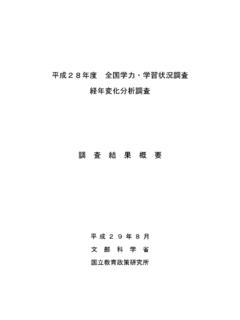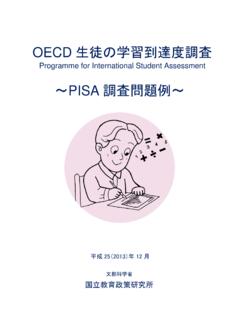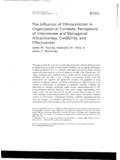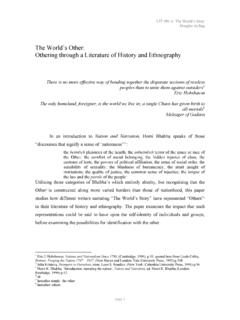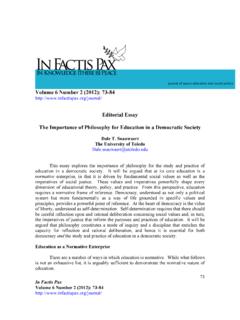Transcription of Education in Japan: Past and Present - NIER
1 1 Education in japan : past and Present The introduction of a modern Education into japan , taking several Western countries as models, began in the latter part of the 19th century. The arrival of modernization in japan was therefore comparatively late, but Education underwent very rapid development within a short space of time. In that time, the following particular socio-cultural conditions in japan were favorable for the development of Education . Initial conditions favoring the development of modern Education (1) For the preceding 250 years of the Edo period, during which japan followed a policy of keeping the country closed to the outside world under the Tokugawa shogunate (1603-1868), the country enjoyed a long period of peace and social stability.
2 Under these conditions, the people of japan were able to attain quite a high level of cultural maturity. There was a relatively wide diffusion of distinctively Japanese educational institutions. For the samurai warrior class, there were institutions for public Education (Hank or fief schools) in which to learn classic Chinese literatures (Confucian Studies). On the other hand, private academies (Shijuku), equivalent to secondary schools, developed and were open to all regardless of Social classes. And there were also a large number of popular learning houses called Terakoya, which concentrated on teaching the practical skills of reading and writing to the commoners.
3 Among the merchant and the technician-worker classes, an apprenticeship system was developed. And among the people it was popular to learn the tea ceremony, flower arrangement, classical musical instruments and other traditional arts. (2) Education had a strongly secular character, and the traditional religions such as Buddhism and Shintoism did not have their own distinctive educational institutions. Moreover, thanks to comparatively homogeneous cultural and linguistic traditions, there was no problem with making Japanese the sole medium of teaching from the start. (3) As a result of the feudal system and the system of social classes, the formation of a common national consciousness had been held back.
4 However, amidst the atmosphere of crisis in the face of external pressure at the end of the Edo period, there was a strong awareness that national unity and national consciousness could be formed through Education . In the process of groping to modernize the nation in the mid-19th century, a consensus was formed with the aim of abolishing the traditional class system and offering an equal educational opportunity to all people of japan . (4) Near the end of the Edo period, a system that recruited people on the basis of individual knowledge and ability was introduced in place of the traditional class system. It became clear that the elite members of the society were being selected on the basis of their academic attainment.
5 In this way, the initial conditions had been lain for the advent of a academic-credentials society in which employment and social status were decided on the basis of a person s educational attainment. 2 (5) japan maintained its independence and as it was not colonized by the great powers of the West, it did not have the colonial legacy in Education introduced by former rulers, as was the case with many other developing countries. Consequently, at the time that the modern educational system was introduced, japan was able to select at will and to try out various models provided by different developed countries.
6 1. Introduction of a modern Education system: 1868-1885 Opening of the country and the Meiji Restoration In 1868, a political revolution took place in japan , marked by the collapse of the political power held by the Tokugawa shogunate, and the birth of a new system of political authority with the Emperor at its head. The beginnings of the modernization of japan can be seen in this revolution known as the Meiji Restoration. Meiji comes from the name of the Emperor Meiji . During Edo period, the shogunate government had adopted a policy of keeping the country closed to the outside world, but in the early part of 19th century, it faced a great pressure and military threats from a number of western countries that demanded that japan open its doors.
7 In the final stages of the Edo period, japan fell into a state of civil war. The feudal system had hampered the emergence of a national consciousness. The new government under Emperor Meiji attempted to overcome this crisis by abolishing the feudal regime and turning japan into a unified, modern nation-state. Adopting as its main slogans, Civilization and Enlightenment (Bunmei kaika), Enrich the Country, Strengthen the Military (Fukoku ky hei), the new government introduced modern social and economic systems to japan . Educational reforms were also included within this modernization package.
8 The concept of the Education System Ordinance In 1871, the Ministry of Education was established and in the following year, 1872, the first systematic Education regulation was promulgated in the form of the Education System Ordinance (Gakusei). The school system followed the American model of the time, which consisted of three levels of schooling, elementary school, middle school and university. On the other hand, the administrative system followed the French, with strong central control by Ministry of Education and the system of school districts. Under the Education System Ordinance, the plan for the establishment of schools took the following form.
9 The entire country was divided into eight university districts, each of these was divided into 32 middle school districts, and each of these was further divided into 210 elementary school districts. In principle, all children were required to attend to elementary school, regardless of sex, parental occupation, or social status. Traditional educational institutions were transformed and incorporated into the new systems. Many Terakoya or popular learning houses for teaching reading and writing and practical skills to the commoners, became elementary schools and many Hanko (fief schools) for the samurai warrior class were transformed into local middle schools.
10 Although the Sh hei-zaka Gakumonjo, 3 the supreme Confucian Education institution established by the shogunate government, was abolished, two other Western-style educational establishments set up during the late Edo period, the Kaisei-jo (School of Western Studies) and a medical institute, continued to exist after the Meiji Restoration and eventually developed into the University of Tokyo. To modernize the contents and methods of elementary Education , in 1872, the government invited a specialist in teacher Education from the United States, and the Tokyo Normal School was established. Employment of foreign consultants and sending students overseas to study In the early years of the Meiji era, the government employed many foreign consultants while paying them exceptionally high salaries.


